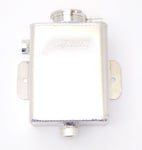The main job of an expansion tank has to do with, not surprisingly, expansion. As a basic requirement, expansion tanks should allow enough space for coolant to expand at normal operating temperature and not be pushed out of the pressure relief fitting in the neck.

The general rule of thumb for proper capacity of expansion is 12% of total coolant volume for draw down and 6% of the total volume for thermal expansion.
Drawdown capacity is the amount of coolant that can be lost before air reaches the water pump and is introduced into the system. Air bubbles in the coolant system can cause inconsistent cooling and can also prevent the thermostat from opening if an air bubble gets trapped underneath it.
Thermal expansion occurs as coolant accumulates heat from the engine. The 6% of the expansion volume is calculated from the amount that the coolant level will rise at 212 degrees F. This takes into account the density change of the coolant itself and all the components that are in the coolant system. If the volume is calculated incorrectly and an inadequate expansion space is provided coolant will be discharged from the system at operating temperature. To prevent the possibility of spilling coolant a catch tank or a recovery tank can be used.
To get the proper expansion tank volume we need to add together the draw down capacity requirement and the thermal expansion requirement to get an additional 18% total volume required for the expansion tank. Most coolant systems are designed to operate with about 13 qts in the system. If we use a 13 qt system as our model. We would use the calculations below:
Drawdown = 12% of 13 qts = 1.56 qts
Thermal Expansion = 6% of 13 qts = .78 qts
Expansion Tank Size Required = 2.34 qts
In a 13 qt System a 2.34 qt expansion tank would be required. In a situation where a large enough tank isn't available a recovery tank can be used in order to take up some of the expansion volume needed. A recovery tank will collect any coolant that is expelled from the pressure relief. In a set up with a recovery tank it is important to make sure that the coolant system is still full enough to allow for drawdown. For more info on setting up your coolant tank system, see our "Setting up Your Cooling System" blog post.
If you would like to know about the features to consider when choosing a tank open up our Aluminum Tank Designer's Guide by clicking below.

